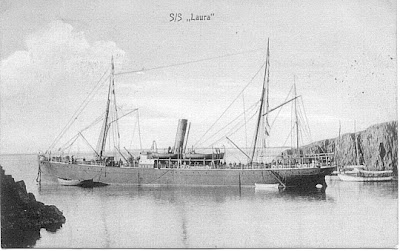
I recently posted how the fishermen of the fishing hamlet of Dunure rescued all but two souls from the crews of the Valkyrian and the Iron Duke. Both ships were wrecked on the reefs of Dunure on the night of 11th December 1883. Who would have thought that the bravery of Buckie and his neighbours that night would have resulted in the birth of one of the World's largest shipping lines?

One of the lucky men to be rescued that night was Captain Peter Maersk Moller of the Valkyrian. She was a 381 ton Danish sailing barque bound for Glasgow from Virginia when she got caught in hurricane force winds in the Clyde. Her sails were torn away and she drifted towards the Ayrshire coast. She tried to put out her anchor but the cable broke before the steam paddle tug Iron Duke could reach her. The Iron Duke's engine failed and she was also driven onto the rocks at Dunure and wrecked shortly afterwards.
Here is an account in Captain Maersk Moller's own words:
"The "Valkyrian" sailed on 7th November 1883 from New Port Mews, Virginia, carrying walnut wood. The voyage was smooth, on Thursday 11th December, I passed close by Corsewall Point in a moderate southerly gale. When the watch was set at 8p.m. there was a strong gale, SW to SSW. We drifted along the coast with enough room to keep going throughout the night, but at about 10p.m. the wind veered to WNW and NW in a squall. The sails were blown away like paper. We were then off Turnberry and Ailsa Craig heading WNW and had signalled for a pilot. Land was a few miles to leeward. I called the men to the cabin and explained the situation. I read from the bible and we said a prayer. We could do no more then, but later given the chance, we had to try the best to save ourselves. The ship was driven onto the rocks at Dunure and brokeup. All but one poor sailor was saved, due to the bravery of the men of Dunure."

The Dunure fishermen had managed to save all but Henrie Jansen who was swept away by a giant wave in the darkness. The wooden Valkyrian was smashed to smithereens and just about all that was left was her bell. The bell remained in the possession of William Munro's descendents until they presented it to the descendants of Captain Maersk Moller in 1985.
Captain Maersk Moller returned to the sea and three years later on 16/12/1896 he bought a British built steamship, the SS Laura, from the DFDS line that operated her on the Faroe Island service.

This stamp was issued on 21 February 1983 when SS Laura still sailed under DFDS colours.

Under Captain Maersk Moller, SS Laura continued on the Copenhagen Faroe Island run with a stop each way at Granton near Edinburgh. This photograph was taken in 1908 a year before she was sold. She was subsequently wrecked on the coast of Iceland in 1910.
Captain Maersk Moller painted a light blue stripe on her funnel with a white star on it. He believed it was his lucky star. In 1904 he founded the "The Steamship Company Svendborg" with his son Arnold Peter Maersk Moller. AP did not always agree with his father and the other board members and eight years later went on to found the "Steamship Company of 1912". This has grown into AP Moller-Maersk which is one of the largest companies in the world. Maersk Line container ships such as the Emma Maersk are some of the largest ships afloat.

This is Arnold Maersk McKinney Moller. He was CEO of the company from 1965 until 1993. He is Captain Peter Maersk Moller's grandson.

In 1985, in exchange for the bell of the Valkyrian he presented Mr William Munro, who is a descendent of Buckie Munro, with a painting of the Valkyrian, which had hung in his office at AP Moller-Maersk for many years.
I wonder if Buckie's pipe was made of walnut!
Lastly, I hope that you, the reader, will now realize why we do not paddle from headland to headland!
References
Ayrshire roots.
Dansk Posthistorisk Selskab.
Faroese Stamps.
AP Moller-Maersk.
Mr William Munro 5/02/2008
20/01/2008






















